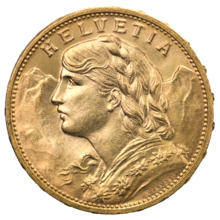Vreneli
| Switzerland | |
| Value | Swiss franc |
|---|---|
| Edge | minted |
| Composition | .900 gold |
| Years of minting | 1897–1936, 1947, 1949 |
| Obverse | |
 |
|
| Design | Coat of arms of Switzerland |
| Reverse | |
 |
|
| Design | Helvetia |
| Designer | Fritz Ulysse Landry |
| Design date | 1895 |
Vreneli is the informal name for a range of legal tender gold coins produced in Switzerland. The formal name is: Tête d'Helvetia (French), Helvetiakopf (German) or Helvetia Head (English). The coins were issued between 1897 and 1936, in 1947 and in 1949. All coins issued after 1936 are restrikes (legal tender ceased September 29, 1936).
These coins had face values of 10, 20 and 100 Swiss francs and were minted in a millesimal fineness of 900. The coins are sometimes colloquially called “Swiss Miss,” from the obvious obverse motif. The 20 franc coin's reverse shows the Swiss shield, featuring the Swiss Cross, and a wreath of oak along with the denomination. The coins were minted at the Swiss Mint at Bern (although the die engraving was done at the Paris mint) and the coins are mint marked with a "B" (without a period). The 20 franc coins are 21 mm in diameter (about the size of a U.S. five cent piece), 1.25 mm in thickness, weigh 6.45 grams (gross weight) and; at 90% pure, contain .1866 ounces or 5.805 grams of pure gold. The 10 franc coin weighs 3,23g and at 90% purity contains 2.9 grams of pure gold.
The coins were issued between 1897 and 1936, in 1947 and in 1949.
Around 61 million coins were minted, although only 5,000 of the 100 franc pieces were produced and only in the year 1925. The 20 Franc coin is the most common, and it is popular as a bullion coin. However, the coins also hold a place in numismatic circles.
Among the 20 franc pieces, the 1926 coin with its mintage of only 50,000 pieces is the ostensible key to that series. However, the 1926 is relatively fairly common and the real keys to the series are said to be the 1903 and the 1904. This is based upon the fact that the major coin grading services have graded less than 10 coins of each date in all grades, while the 1926 has a graded population of over 200. Of course, populations depend upon the numbers of coins actually submitted by collectors which is inexorable tied to the popularity of a coin series, or lack thereof among collectors. For a critique of population reports see Doug Winter's essay, February 2002.
The 100 franc denomination was only struck in 1925 with a very limited mintage of 5,000.
The 10 franc denomination was struck in 1911 (100,000) through 1916 (130,000), inclusive, and in 1922 (10,200,000). Although the obverse is the same for the 10, 20 and 100 franc pieces, the reverse of the 10 and 100 are common depicting a radiant Swiss Cross above a branch.
In 1935, 175,000 regular strikes of the 20 franc coins were produced. However, an additional twenty million (20,008,813) coins dated "L1935B" with the "L" indicating "lingot" or bullion and the "B" indicating the Bern mint, were re-struck in 1945 (3,500,000), 1946 (7,108,813) and 1947 (9,400,000). An additional 9,200,000 coins contemporaneously struck and dated in 1947 were also produced and are distinguished by the mint mark "B". There were no regular strikes produced in the years 1945 and 1946.
...
Wikipedia
